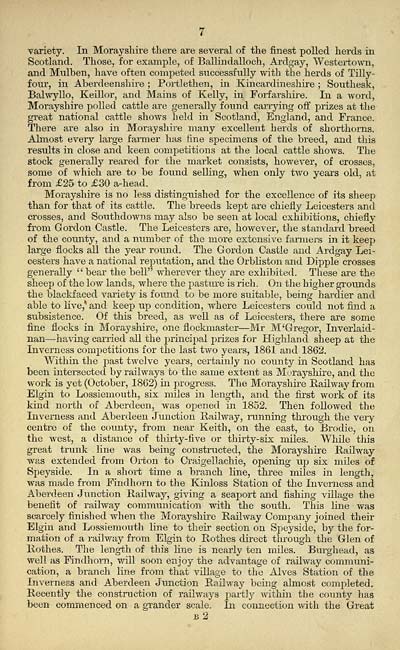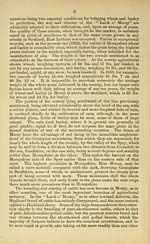Counties > Moray (Elgin) and Nairn Shires > 1863 - Black's Morayshire directory, including the upper district of Banffshire
(19)
Download files
Complete book:
Individual page:
Thumbnail gallery: Grid view | List view

variety. In Morayshire there are several of the finest polled herds in
Scotland. Those, for example, of Ballindalloch, Ardgay, Westertown,
and Mulben, have often competed successfully with the herds of Tilly-
four, in Aberdeenshire ; Portlethen, in Kincardineshire ; Southesk,
Balwyllo, Keillor, and Mains of Kelly, in Forfarshire. In a word,
Morayshire polled cattle are generally found carrying off prizes at the
great national cattle shows held in Scotland, England, and France.
There are also in Morayshire many excellent herds of shorthorns.
Almost every large farmer has fine specimens of the breed, and this
results in close and keen competitions at the local cattle shows. The
stock generally reared for the market consists, however, of crosses,
some of which are to be found selling, when only two years old, at
from £25 to £30 a-head.
Morayshire is no less distinguished for the excellence of its sheep
than for that of its cattle. The breeds kept are chiefly Leicesters and
crosses, and Southdowns may also be seen at local exhibitions, chiefly
from Gordon Castle. The Leicesters are, however, the standard breed
of the county, and a number of the more extensive farmers in it keep
large flocks all the year round. The Gordon Castle and Ardgay Lei-
cesters have a national reputation, and the Orbliston and Dipple crosses
generally "bear the bell" wherever they are exhibited. These are the
sheep of the low lands, where the pasture is rich. On the higher grounds
the blackfaced variety is found to be more suitable, being hardier and
able to live,* and keep up condition, where Leicesters could not find a
subsistence. Of this breed, as well as of Leicesters, there are some
fine flocks in Morayshire, one flockmaster— Mr M'Gregor, Inverlaid-
nan — having carried all the principal prizes for Highland sheep at the
Inverness competitions for the last two years, 1861 and 1862.
Within the past twelve years, certainly no county in Scotland has
been intersected by railways to the same extent as Morayshire, and the
work is yet (October, 1862) in progress. The Morayshire Railway from
Elgin to Lossiemouth, six miles in length, and the first work of its
kind north of Aberdeen, was opened in 1852. Then followed the
Inverness and Aberdeen Junction Railway, running through the very
centre of the county, from near Keith, on the east, to Brodie, on
the west, a distance of thirty-five or thirty-six miles. While this
great trunk line was being constructed, the Morayshire Railway
was extended from Orton to Craigellachie, opening up six miles of
Speyside. In a short time a branch line, three miles in length,
was made from Findhorn to the Kinloss Station of the Inverness and
Aberdeen Junction Railway, giving a seaport and fishing village the
benefit of railway communication with the south. This line was
scarcely finished when the Morayshire Railway Company joined their
Elgin and Lossiemouth line to their section on Speyside, by the for-
mation of a railway from Elgin to Rothes direct through the Glen of
Rothes. The length of this line is nearly ten miles. Burghead, as
well as Findhorn, will soon enjoy the advantage of railway communi-
cation, a branch line from that village to the Alves Station of the
Inverness and Aberdeen Junction Railway being almost completed.
Recently the construction of railways partly within the county has
been commenced on a grander scale. In connection with the Great
b2
Scotland. Those, for example, of Ballindalloch, Ardgay, Westertown,
and Mulben, have often competed successfully with the herds of Tilly-
four, in Aberdeenshire ; Portlethen, in Kincardineshire ; Southesk,
Balwyllo, Keillor, and Mains of Kelly, in Forfarshire. In a word,
Morayshire polled cattle are generally found carrying off prizes at the
great national cattle shows held in Scotland, England, and France.
There are also in Morayshire many excellent herds of shorthorns.
Almost every large farmer has fine specimens of the breed, and this
results in close and keen competitions at the local cattle shows. The
stock generally reared for the market consists, however, of crosses,
some of which are to be found selling, when only two years old, at
from £25 to £30 a-head.
Morayshire is no less distinguished for the excellence of its sheep
than for that of its cattle. The breeds kept are chiefly Leicesters and
crosses, and Southdowns may also be seen at local exhibitions, chiefly
from Gordon Castle. The Leicesters are, however, the standard breed
of the county, and a number of the more extensive farmers in it keep
large flocks all the year round. The Gordon Castle and Ardgay Lei-
cesters have a national reputation, and the Orbliston and Dipple crosses
generally "bear the bell" wherever they are exhibited. These are the
sheep of the low lands, where the pasture is rich. On the higher grounds
the blackfaced variety is found to be more suitable, being hardier and
able to live,* and keep up condition, where Leicesters could not find a
subsistence. Of this breed, as well as of Leicesters, there are some
fine flocks in Morayshire, one flockmaster— Mr M'Gregor, Inverlaid-
nan — having carried all the principal prizes for Highland sheep at the
Inverness competitions for the last two years, 1861 and 1862.
Within the past twelve years, certainly no county in Scotland has
been intersected by railways to the same extent as Morayshire, and the
work is yet (October, 1862) in progress. The Morayshire Railway from
Elgin to Lossiemouth, six miles in length, and the first work of its
kind north of Aberdeen, was opened in 1852. Then followed the
Inverness and Aberdeen Junction Railway, running through the very
centre of the county, from near Keith, on the east, to Brodie, on
the west, a distance of thirty-five or thirty-six miles. While this
great trunk line was being constructed, the Morayshire Railway
was extended from Orton to Craigellachie, opening up six miles of
Speyside. In a short time a branch line, three miles in length,
was made from Findhorn to the Kinloss Station of the Inverness and
Aberdeen Junction Railway, giving a seaport and fishing village the
benefit of railway communication with the south. This line was
scarcely finished when the Morayshire Railway Company joined their
Elgin and Lossiemouth line to their section on Speyside, by the for-
mation of a railway from Elgin to Rothes direct through the Glen of
Rothes. The length of this line is nearly ten miles. Burghead, as
well as Findhorn, will soon enjoy the advantage of railway communi-
cation, a branch line from that village to the Alves Station of the
Inverness and Aberdeen Junction Railway being almost completed.
Recently the construction of railways partly within the county has
been commenced on a grander scale. In connection with the Great
b2
Set display mode to: Large image | Transcription
Images and transcriptions on this page, including medium image downloads, may be used under the Creative Commons Attribution 4.0 International Licence unless otherwise stated. ![]()
| Scottish Post Office Directories > Counties > Moray (Elgin) and Nairn Shires > Black's Morayshire directory, including the upper district of Banffshire > (19) |
|---|
| Permanent URL | https://digital.nls.uk/85597089 |
|---|
| Description | Directories of individual Scottish counties or parts of counties. |
|---|
| Description | Around 700 Scottish directories published annually by the Post Office or private publishers between 1773 and 1911. Most of Scotland covered, with a focus on Edinburgh, Glasgow, Dundee and Aberdeen. Most volumes include a general directory (A-Z by surname), street directory (A-Z by street) and trade directory (A-Z by trade). |
|---|


